|
Double L Acres' Foal Development Page

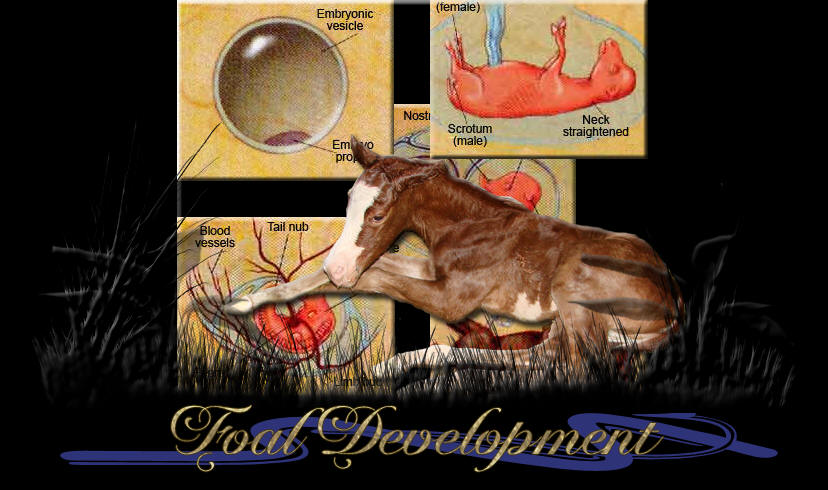

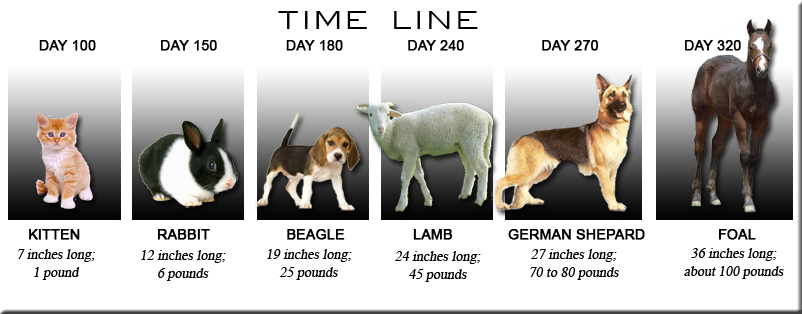

FOAL DEVELOPMENT TIME LINE
|
Click on smaller
pictures to enlarge.
|
|
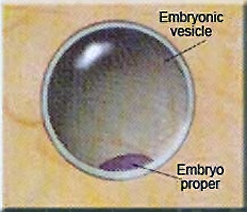
|
Day 9
With the naked eye, you can see only the "embryonic vesicle" which houses the embryo. The vesicle looks like a shimmering, firm, translucent bubble, less than ¼ inch in diameter. On the ultrasound screen, you will see it as a black circle in a sea of grainy gray (your mare's uterus). At this point, the embryo is no larger than a pinpoint.
|

PINPOINT
Microscopic size;
3/2000 ounce |
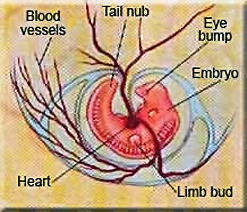 |
Day 24
The vesicle has grown to 1 inch in diameter. It's a shimmering, flabby, translucent bubble with a dark red dot (the embryo) at one end. A network of threadlike blood vessels emanates from the ¼ inch dot. You can barely make out the beginnings of animal features: a head, tiny bumps that will become eyes; a fleshy tail nub; and four little buds that will eventually become legs. On the ultrasound monitor, you will see the vesicle as an irregular, guitar-pick shaped black blob in a sea of grainy gray. Generally, around Day 24 an embryonic heart is large enough to be seen on the ultrasound screen. To find it, focus on the "floor" surface of the blob. You will see a white smudge, about ½ inch in diameter, resting there; this is the embryo. Within the smudge, a tiny black dot, about the size of a pinpoint, will be flashing on and off like a computer's screen's cursor-this is the pea sized embryo's beating heart.
|

PEA
1/4 inch in diameter; 5/1000 ounce |
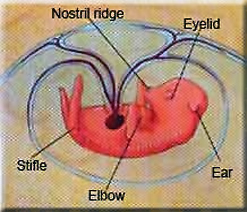 |
Day 40
The vesicle is now 2 ½ inches in diameter, roughly spherical in shape, and somewhat collapsed. The ¾ inch embryo within is now recognizable as a four-legged critter: it has a blobby dome for a head, eyelids, rudimentary ears, ridges where the nostrils will be, and functional elbows an stifle joints. An ultrasound would reveal the vesicle as a roundish black blob: look for the white smudge of an embryo to be suspended from the blob's ceiling, rather than resting on its floor. This shift of position is step one in what researchers call "the rise and fall of the embryo." It results from filmy membranes at the top of the vesicle coming together to form the umbilical cord. As they do so, they shorten, pulling the olive-sized embryo up to the ceiling like a chandelier.
|

OLIVE
3/4 inch long, from crown to rump; just under half an ounce |
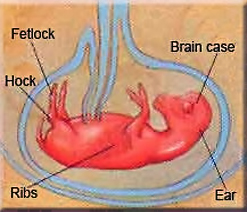 |
Day 50 to 55 of Pregnancy
The embryo is now slightly over an inch long, nesting within the confines of the 3-inch vesicle. You can see tiny ribs under its skin; its domed head looks like that of a Chihuahua, and has developed a distinct skull. Little triangles represent its ears; the hock and fetlock joints have developed. At this stage, your future foal officially will graduate from embryo to fetus. On an ultrasound monitor, you'll find the fetus back on the vesicle's floor, due to a lengthening of the umbilical cord. Because of its size-now about that of a pecan-this will be your last opportunity to view the fetus via ultrasound; in a matter of weeks, it'll be too large for the screen.
|

PECAN
1 inch in diameter; less than an ounce |
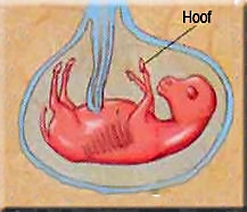 |
Day 60
The vesicle is now flabby and shapeless, conforming to the uterine walls; the fetus is about 2 1/2 inches long. You can see that it clearly resembles a horse, thanks to the development of tiny hooves, complete with soles and frogs. Its head is still tucked, but less so than before. The fetus is hairless, and about the size of a hamster.
|

HAMSTER
2.5 inches long; 1 ounce |
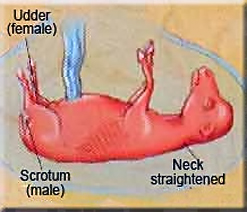 |
Day 80
The fetal head and neck will be untucked, and are being held level with the spine in the "normal" horse position. Its sex is now viable: you can see that little lumps have formed for the scrotum, if it's a male, or the udder, if it's a female. The fetus is now about the size of a chipmunk.
|

CHIPMUNK
4 inches long;
2 ounces |
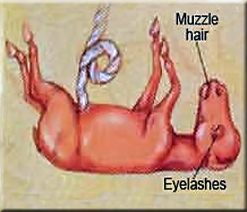 |
Day 100
Your mare's 7-inch fetus is about the size of a 6-week old kitten. You can see a bit of hair on its lips; its ears are unfurling from its head. They're now nearly 1/2 inch long and are curled forward. The coronary bands look like raised lines encircling the tops of its tiny 1/4-inch hooves.
|

KITTEN
7 inches long; 1 pound |
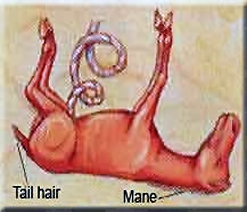 |
Day 150
Gaining more than a pound every 10 days, the fetus now is about the size of a rabbit. Hair graces its chin, muzzle, and eyelids. If you look closely, you'll see that eyelashes have emerged.
|

RABBIT
12 inches long;
6 pounds
|
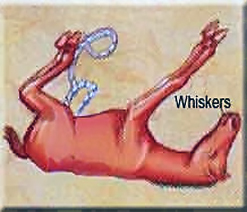 |
Day 180
The fetus has quadrupled its weight in just 30 days. Mane and tail hairs have appeared; it's about the size of a Beagle.
|

BEAGLE
19 inches long;
25 pounds |
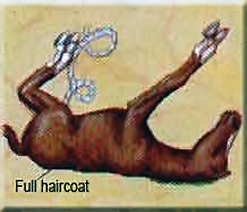 |
Day 270
Your mare's fetus now looks like a foal: fine hair covers its body, and it now has a swatch of hair on its tail. It's about the size of a German Shepherd.
|

GERMAN
SHEPARD
27 inches long;
70 to 80 pounds |
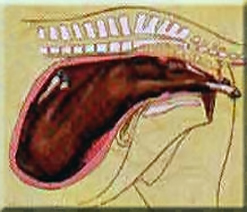 |
Day 320
In the last week or so, the fetus's lungs have developed to the point that they can function in the "real world"; its legs have strengthened to the point that they can support is weight; and its hair has coarsened, from the fine, silky texture of fetus hair, to that of a bonafide foal. As far as development goes, the fetus is "done." You'll get the chance to meet your mare's foal in a matter of days or weeks. (Normal equine gestation can range from 320 to 365 days.)
|

FOAL
36 inches long;
about 100 pounds |

Equine Ultrasounds

EQUINE DEVELOPMENT
Click on pictures to enlarge
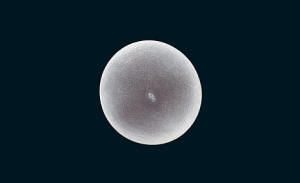 |
DAY 10
This perfect ball is an equine embryo, 3.8mm in diameter and just ten days into its 11-month gestation period.
The tiny bright fleck in the middle is the inner cell mass which will eventually form the fetus proper. The remaining cells will form the placental membranes.
|
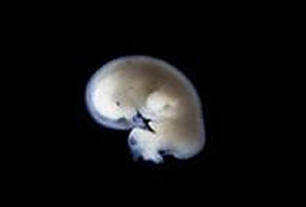

|
DAY 20 |
|
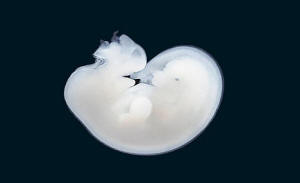

|
DAY 30 - 1 MONTH
Rather than attaching itself to the side of the womb, as with humans, the embryo will move up and down in the uterus, emitting a hormonal signal that causes tiny contractions and stops the mare coming back into season.
Other than a slight increase in blood flow to the uterus, the mare will be experiencing few physical changes.
he basic body plan, together with limb buds and the beginnings of a tail, is now formed and measures 12mm from the crown of its head to its rump.
The tiny heart, already pumping, has been visible on scans for the past week and the rudimentary beginnings of other essential organs - stomach, liver, pancreas, lungs - are evident.
The fuzzy-looking outer sac, part of the placental membrane, is called the amnion. The foal will be encased in this slippery, translucent-white membrane when it is born.
The mare will still show no external signs of pregnancy and will continue racing as usual. Mares do not suffer morning sickness - a horse can regurgitate food, but cannot actually be sick.
|
 |
DAY 36 - 1.2 MONTHS |
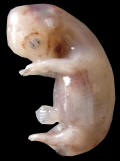 |
DAY 40 - 1.3 MONTHS |
 |
DAY 54 - 1.7 MONTHS |
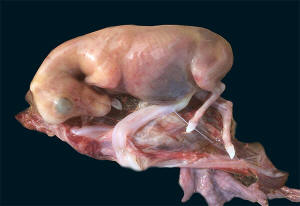
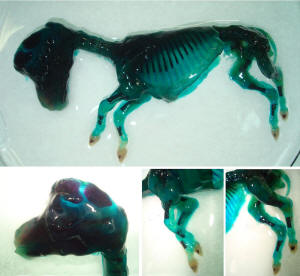 |
DAY 60 - 2 MONTHS
Crown to rump length is 64.5mm, the fetus is clearly recognizable as a horse.
Skin becomes thicker and starts to lose transparency. Formation of brainstem encephalic fourth ventricle, spinal cord and transition from bran vesicles to brain are beginning.
Orbital vesicle is present. Gums are forming.
This equine fetus subjected to the modified Alizarin dye technique. Cartilage is light blue, whereas areas of forming bone are dark purple. |
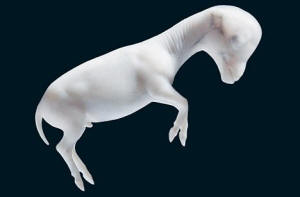 |
DAY 65 - 2.1 MONTHS
Now 69mm from crown to rump.
The skin remains pale and hairless, and the eyes are still sealed shut, but the internal organs are developing, muscles are growing, hoof-shaped feet are forming and the frog - the rubbery pad on the bottom of the foot which acts as a pump to move blood up the thin length of the horse's leg and back to the heart - is forming.
The sex of the fetus can now be determined. Twins are unusual and unwelcome - mares are not designed to carry two foals to term and vets will usually perform a 'twin reduction' to avoid losing both.
|
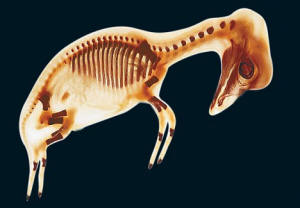 |
DAY 75 - 2.5 MONTHS
A red stain has been used to highlight the developing skeleton, now almost 75mm long.
The darker areas show calcium deposits where the bones are starting to ossify. The hardening skeleton system provides a framework for other body structures and protects the internal organs as they develop.
Although they become less fertile with age, mares have no menopause and can breed from about two years old until the day they die, often in their mid-20s. Miscarriage is now very unlikely.
|
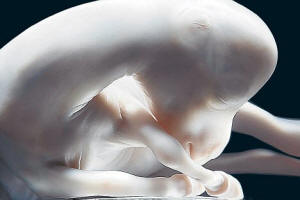
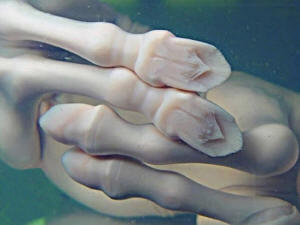 |
DAY 85 - 2.8 MONTHS
The fetus now measures about 100mm and its features are quite distinct, although it remains hairless and pale in the absence of pigment.
The mare will be experiencing hormonal changes and increased blood flow to the uterus - now the size of a melon - but will not yet look pregnant.
|
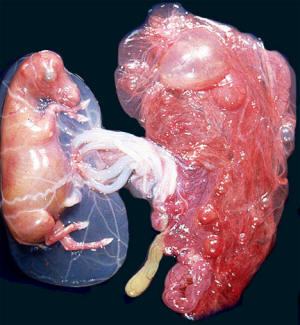 |
DAY 95 - 3 MONTHS
|
 |
DAY 107- 3.5 MONTHS |
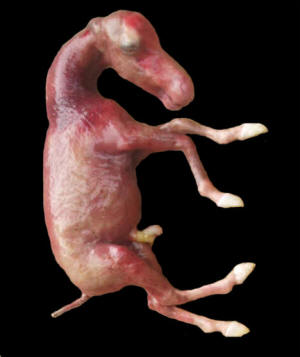
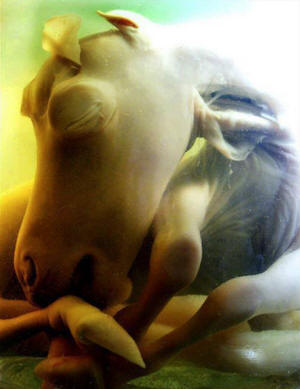 |
DAY 165 - 5.5 MONTHS |
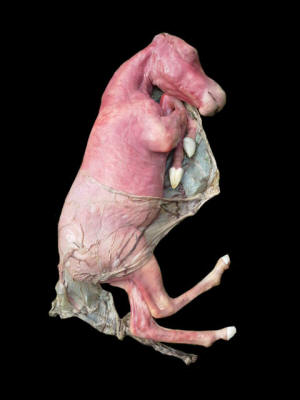 |
DAY 183 - 6 MONTHS |
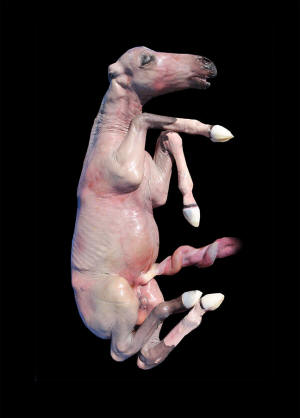 |
DAY 245 - 8 MONTHS |
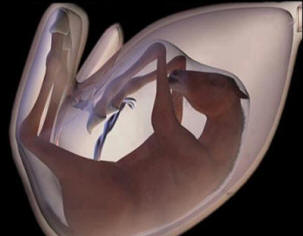 |
DAY 300 - 10 MONTHS |
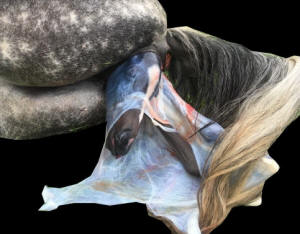 |
DAY 340 BIRTH - 11 MONTHS
Mares need minimal assistance and give birth quickly - usually within about 20 minutes - and lying down.
The foal is delivered in the amnion, the shiny white membrane interlaced with a network of blood vessels, which it breaks as it is born.
The mare will often stay lying down, with the foal's feet still inside her and the umbilical cord attached and passing blood to the foal.
Within an hour, the foal will be up and being licked and nuzzled by its mother.
|
Written by Jane Fryer, Some Photographs by Tim Flach

© Copyright 2002 Double L Acres - All Rights Reserved

TOP OF PAGE
|
|
|
|
|
|
|